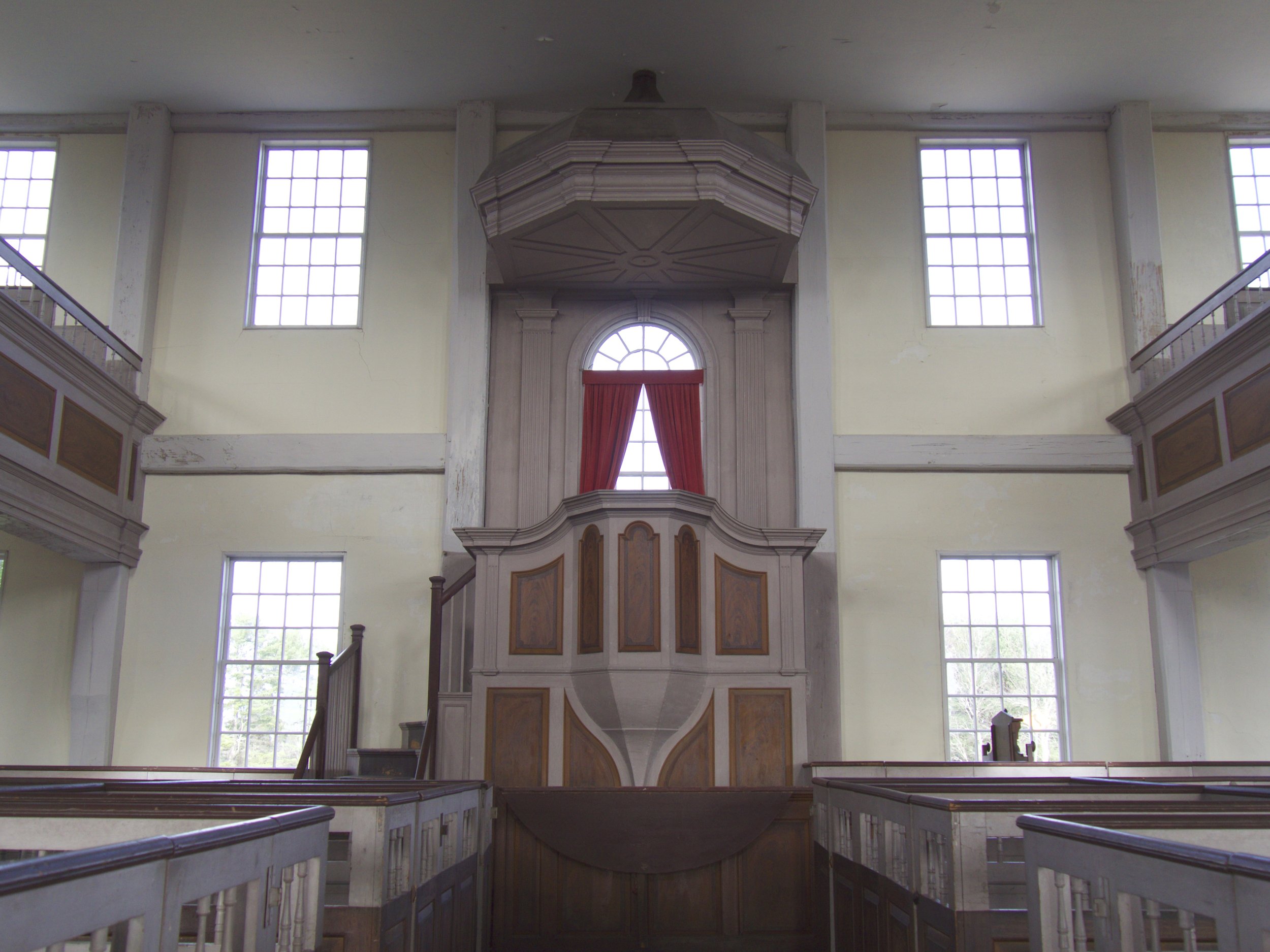Alna Meetinghouse
Text by Brett Donham
In 1790 a petition for separation was submitted to the Massachusetts legislature by farmers and yeomen in the west valley of the Sheepscot River north of Wiscasset. It was granted, Maine being part of Massachusetts at that time. The petition called for creating a new town to be called New Milford because of all the new mills along the Sheepscot River. Twenty years later the townsfolk changed the name to Alna, for the species of tree that grew in abundance along the Sheepscot. The land for the new town would be split off from what we now call Newcastle [to the east] and Dresden [to the west]. Much of the land between the Sheepscot, Eastern, and Kennebec Rovers was gently rolling and well drained soil and most of the early settlers in Alna in the late 1700’s were farmers. The new schoolhouse and meetinghouse were located in the geographic center of the new town, on the highest point of land, in the center of the best farmland. Required attendance at Sunday worship, a day-long affair, strongly suggested that the meetinghouse be located in the center of this farming community. Going to church was “going to meeting”.
Oblique view toward pulpit, showing balcony seating on both sides of the meeting room.
View toward the pulpit, backed by a Palladian window, and topped by a structure above that projects the speaker’s voice toward meeting attendees, regardless of where they are seated.
Faux graining appears throughout the meetinghouse, including this detail of the lower portion of the pulpit.
(Photo Credit © Steve Rosenthal)
But this was not just a farming community. It and other towns of this era were also religious communities. The Town and the Church were one and the same. The Town’s taxes paid the salary of the minister, the construction of his house, and the construction and maintenance of the meetinghouse. The meetinghouse was used for Sunday’s religious services as well as meetings for civic purposes such as deciding town salaries, road repair, alewife rights, setting the tax rate, and other business. To vote in civic meetings one had to be accepted into the church. The church managed public disciplinary problems and could remove troublesome people from town.
A New Era
Forty years after its founding, Alna had become a different town. It reached its peak population of 1138 in 1833 [compared to 710 today]. It had 6 schools, 5 inns and taverns, several saw mills, 5 stores, tanneries, brickyards, a grist mill, a fulling mill, coopers, blacksmiths, a dyeworks, and 2 ship builders.
The center of gravity of town had moved to Head Tide, where, for example, 5 of the mills plus a dormitory for mill workers, 2 warehouses, a school, and a store were located. The social and religious environment had changed, too. New England states had started to dis-establish churches.
People who were members of faith traditions other than the official town church or were not a member of any church began to question why they should be taxed to pay for the official church. Some members of the Alna Meetinghouse petitioned to be relieved of their church taxes.
North Meeting House
(Head Tide Church)
The thing that tipped the scales in Alna’s case was the difficulty in getting to the old meetinghouse in the Winter, during Spring freshets and mud-season. More people now lived closer to Head Tide than to Alna Center, and in 1838 five of the leading men in town offered to acquire a piece of land in Head Tide and take responsibility for funding construction of a new church building there. Initially called the North Meeting House, it looked like what we consider a quintessential New England church.
Now managed and maintained by the Friends of Head Tide Church, the North Meeting House included a curious blend of various architectural elements.
In tearing themselves from the original meetinghouse, the church members seemed to have an emotional need to bring a part of it with them. Like the town’s original meetinghouse, the maine feature of the interior space of the new Head Tide Church was the raised pulpit, adorned with faux wood grain painting, and accessed by a short flight of stairs on each side. Most striking, however, was the false or trompe l’oeil painted window, complete with painted heavy velvet curtain, which occupies much of the wall behind the preacher’s bench. While it is an exact copy of the real window in the 1789 meetinghouse, it is the most architecturally incongruous feature in the new building.
The trompe l’oeil Palladian window behind the pulpit in the Head Tide Church, complete with painted velvet curtain, is reminiscent of the real window in the 1789 meetinghouse.
Make a donation.
The Fund to Support Historic Alna a 501(c)(3) charitable non-profit, whose mission is to help fund the preservation, maintenance, and restoration of historic sites located in the Town of Alna. Your contribution will help with new paint, plaster, maintenance of original wood windows, and so much more. Please consider making a tax-deductible donation today.
Original wooden columns stand among box pews on the first floor, and support capacious balcony spaces above.
(Photo Credit © Steve Rosenthal)






